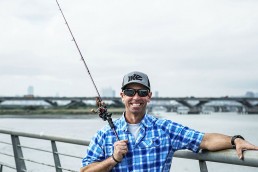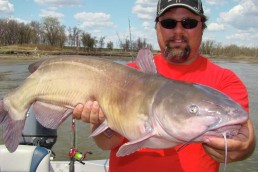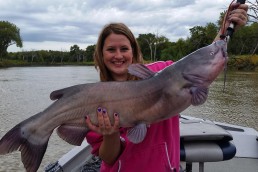New to Catfishing?
SHARE THIS POST
If there was any good thing to come from the pandemic, it is that many new people were introduced to the outdoors. Some tried it for the first time, while others got back to the “how it was” part of their lives. Every species of fish now has new people targeting them, and catfish are no exception.
Fishing licenses and tackle sales were through the roof last year. Nearly every state saw an increase in license sales as people headed outside, largely because it was something they could do. Just look at any lake or river and you would notice many more people. Here on the Red River, I know just about everyone—usually. Last year, I met many new people at the boat ramps and noticed many inexperienced boaters out on the river.
In a recent conversation with a tackle rep, I was told that most companies are still 18 to 24 months behind on restocking many supplies. He told me that if I found the fishing gear I needed for 2021, “Buy it, because you may not find it again this year.” Nobody could have predicted the sudden boom in fishing, but it is a good thing. It could be just the kick that the industry needed.
This leads us to a current situation where we are at a critical crossroad. We now have many new anglers out there who bought a license, plus some fishing gear and at least went fishing a few times. What are we doing to keep them fishing once life goes back to normal?
I have seen many new catfish anglers come into the game, both in person on our local river and asking questions online as to how to proceed as they grow in fishing. People online are trying to help these new anglers, but it is mostly the typical, “Buy this rod and this reel,” rather than, “You have some equipment; maybe pick up one or two of these, and may I recommend this book or talking to this person for some tips that will help you be successful?”
What I am saying here is, we need to back up a moment and teach the fundamentals. We need to take the time to show the basics. It can be as simple as teaching someone how to tie a snell knot or how to choose what is the best weight of sinker for maximum results.
We need to point out a pattern or a structure to look for while fishing to ensure some success to these new anglers. Success in fishing is the key to keeping a new angler coming back for more. They usually don’t have to have lights-out action to be hooked but need some action, and maybe a big fish mixed in, to keep the juices flowing. That will ensure they are hooked, so to speak.
I am as guilty as anyone for wanting to talk about technical stuff. Catfishing is also what I do every day and I have spent many hours and even years in some cases learning about the fish. I take every opportunity to tell others about what I find, but some of it may be over their heads. Not that they won’t understand it, but it is putting the cart before the horse, as they say. Over the next couple of years, I know that I have to make a conscious effort to speak to these people about the fundamentals and do my best to get them a good solid start. The more technical stuff will come later as they grow into their fishing abilities.
Are you enjoying this post?
You can be among the first to get the latest info on where to go, what to use and how to use it!
I recently heard about a catfish tournament series that started with a lower entry fee to run concurrent to the big events. This created a “minor league,” so to speak. It was designed so people new to the catfish game could come in and compete at their own level to build up confidence and skill, to eventually play with the big boys and be competitive. This is a great idea, and I am already trying to figure out how to incorporate something similar into an event or two that I run.
With all the new people, mixed with modern knowledge and technology, comes responsibility. Because of all this added pressure, a fishery cannot survive if everyone keeps everything to take home. More than ever, we as anglers must teach new people to use selective harvest. Besides helping new anglers learn about gear and locations to fish, we need to stress the importance of keeping what you need and letting the trophy fish go back to protect the lake or river, and to give other anglers opportunities in the future.
We don’t have to be forceful about this, but we need to take the time to explain that the learning curve of fishing is so short, that with the help of technology and information, anglers can damage a body of water. We need to make new anglers aware of the need for fish conservation.
This is an area where we can all have good success. I have seen a conscious push for conservation and protecting the species throughout my 20-plus years around the industry. I believe that most new anglers understand how modern ways of fishing and the information superhighway can damage a fishery quickly—and for a generation—if conservation is not observed.
We have an opportunity to advance the sport of fishing. Let’s help these people learn to enjoy the sport that we all love. Show them how to achieve success. Let’s teach them the importance of conservation and let’s not muck it up by scaring people away by making it difficult and expensive. As people get deeper into fishing, the spending of money and studying to no end will take care of itself.
Subscribe to MidWest Outdoors magazine to read more fishing articles like this one!
MWO
SHARE THIS POST
Did you enjoy this post?
You can be among the first to get the latest info on where to go, what to use and how to use it!
Brad Durick
Captain Brad Durick is a nationally recognized catfish guide, seminar speaker, and author of the books Cracking the Channel Catfish Code and Advanced Catfishing Made Easy. For more information: redrivercatfish.com or facebook.com/braddurickoutdoors.



